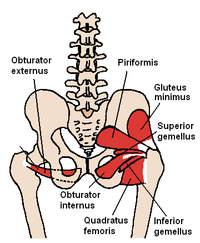- Muscles of the hip
-
In human anatomy, the muscles of the hip joint are those muscles that cause movement in the hip. Most modern anatomists define 17 of these muscles, although some additional muscles may sometimes be considered. These are often divided into four groups according to their orientation around the hip joint: the gluteal group, the lateral rotator group, the adductor group, and the iliopsoas group.
Contents
Gluteal group
The gluteal muscles include the gluteus maximus, gluteus medius, gluteus minimus, and tensor fasciae latae. They cover the lateral surface of the ilium. The gluteus maximus, which forms most of the muscle of the buttocks, originates primarily on the ilium and sacrum and inserts on the gluteal tuberosity of the femur as well as the iliotibial tract, a tract of strong fibrous tissue that runs along the lateral thigh to the tibia and fibula. The gluteus medius and gluteus minimus originate anterior to the gluteus maximus on the ilium and both insert on the greater trochanter of the femur. The tensor fasciae latae shares its origin with the gluteus maximus at the ilium and also shares the insertion at the iliotibial tract.
Adductor group
The adductor brevis, adductor longus, adductor magnus, pectineus, and gracilis make up the adductor group. The adductors all originate on the pubis and insert on the medial, posterior surface of the femur, with the exception of the gracilis which inserts just below the medial condyle of the tibia.
Iliopsoas group
The iliacus and psoas major comprise the iliopsoas group. The iliopsoas is a large muscle that runs from the transverse processes of the T-12 to L-5 vertebrae, joins with the iliacus via its tendon, and connects to the lesser trochanter of the femur. The iliacus originates on the iliac fossa of the ilium. Together these muscles are commonly referred to as the "iliopsoas".
Lateral rotator group
This group consists of the externus and internus obturators, the piriformis, the superior and inferior gemelli, and the quadratus femoris. These six originate at or below the acetabulum of the ilium and insert on or near the greater trochanter of the femur.
Movement of the hip joint
Flexion of the hip occurs when the angle between the torso and thigh is decreased. When this angle is increased extension occurs; beyond normal standing posture, the movement is called hip hyperextension. Hip rotation occurs when the femur moves along its longitudinal axis. When the anterior surface of the femur turns outward, this is lateral rotation of the hip. The movement of the anterior surface of the femur inward is medial rotation of the hip. Medial rotation of the hip is carried out by gluteus medius and gluteus minimus. Hip abduction occurs when the femur moves outward to the side, as in taking the thighs apart. Hip adduction occurs when the femur moves back to the midline.
Many of the hip muscles are responsible for more than one type of movement in the hip, as different areas of the muscle act on tendons in different ways.
The psoas is the primary hip flexor, assisted by the iliacus. The pectineus, the adductors longus, brevis, and magnus, as well as the tensor fasciae latae are also involved in flexion.
The gluteus maximus is the main hip extensor, but the inferior portion of the adductor magnus also plays a role.
The adductor group is responsible for hip adduction. Abduction primarily occurs via the gluteus medius as well as the gluteus minimus.
Medial rotation is performed by the glutaei medius and minimus, as well as the tensor fasciae latae and assisted by the adductors brevis and longus and the superior portion of the adductor magnus.
Each muscle of the lateral rotator group causes lateral rotation of the thigh. These muscles are aided by the gluteus maximus and the inferior portion of the adductor magnus.
Other hip muscles
Additional muscles, such as the rectus femoris and the sartorius, can cause some movement in the hip joint. However these muscles are primarily concerned with the movement of the knee, and are therefore not generally classified as muscles of the hip.
The hamstring muscle group, which mostly originates from the ischial tuberosity inserting on the tibia/fibula, has a large moment assisting with hip extension.
Sources
- Calais-Germain, Blandine. "Anatomy of Movement", Eastland Press, 1993. ISBN 0-939616-17-3
- Martini, Frederic; Timmons, Michael; McKinnley, Michael. "Human Anatomy", 3rd Edition, Prentice-Hall, 2000. ISBN 0-13-010011-0
- Marieb, Elaine. "Essentials of Human Anatomy and Physiology", 6th Edition. Addison Wesley Longman, 2000. ISBN 0-8053-4940-5
- Netter, Frank H. "Atlas of Human Anatomy", 2nd Edition, Icon Learning Systems, 2001. ISBN 0-914168-81-9
Categories:
Wikimedia Foundation. 2010.



